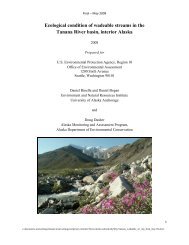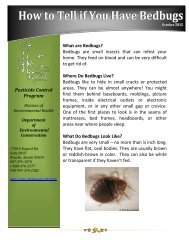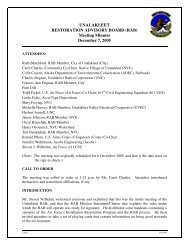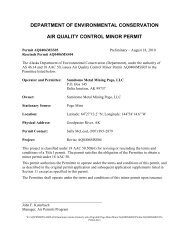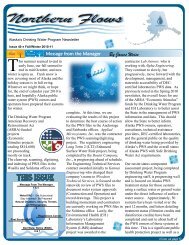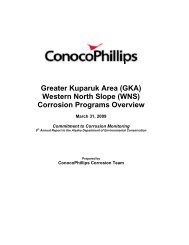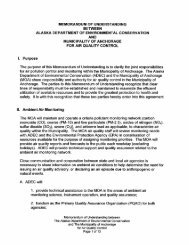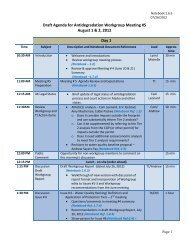2012 Ocean Ranger Guidebook Revision 3-7-12 - Alaska ...
2012 Ocean Ranger Guidebook Revision 3-7-12 - Alaska ...
2012 Ocean Ranger Guidebook Revision 3-7-12 - Alaska ...
Create successful ePaper yourself
Turn your PDF publications into a flip-book with our unique Google optimized e-Paper software.
<strong>20<strong>12</strong></strong> <strong>Ocean</strong> <strong>Ranger</strong> <strong>Guidebook</strong> 3-7-<strong>12</strong><br />
Shipboard dry cleaning facilities use a chlorinated solvent called perchlorethylene (also<br />
known as PERC or tetrachloroethylene) as a dry cleaning fluid. This is the approved dry cleaning<br />
solvent for these units. Operators must receive specific required training for the correct use of<br />
this chemical and its associated precautions. This solvent should be used in accordance with all<br />
safety procedures including appropriate personal protective equipment (PPE).<br />
The dry cleaning units produce a small volume waste from condensate, the bottoms of the<br />
internal recovery stills, waste products from button and lint traps, spent perchloroethylene and<br />
filter media. This waste is comprised of dirt, oils, filters material, and spent solvent. Each ship<br />
utilizing these dry-cleaning units produces approximately two pounds of waste material weekly.<br />
However, the amounts may vary greatly by season and passenger load. This material is classified<br />
as hazardous waste under RCRA and must be disposed of accordingly.<br />
Handling Method 1 Employed by Member Lines:<br />
Perchloroethylene (PERC) and other chlorinated dry-cleaning fluids, contaminated sludge and<br />
filter materials are hazardous waste and landed ashore in accordance with the requirements of<br />
RCRA.<br />
C. Print Shop Waste Fluids: CLIA member lines have agreed to prevent the discharge<br />
of hazardous wastes from printing materials (inks) and cleaning chemicals into the<br />
environment.<br />
Print shop waste may contain hazardous waste. Printing solvents, inks and cleaners all<br />
may contain hydrocarbons, chlorinated hydrocarbons, and heavy metals that can be harmful to<br />
human and aquatic species. Recent advances in printing technology and substitution of chemicals<br />
that are less hazardous reduces the volume of print shop waste generated and reduces the impact<br />
of these waste products.<br />
CLIA member lines have agreed to utilize, whenever possible, printing methods and<br />
printing process chemicals that produce both less volume of waste and less hazardous waste<br />
products, that shipboard printers will be trained in ways to minimize printing waste generated,<br />
and that alternative printing inks such as soy based, non-chlorinated hydrocarbon based ink<br />
products will be used whenever possible. The member lines have further agreed that all print<br />
shop waste including waste solvents, cleaners, and cleaning cloths will be treated as hazardous<br />
waste, if such waste contains chemical components that may be considered as hazardous by<br />
regulatory definitions, and that all other waste may be treated as non-hazardous.<br />
Handling Method 1 Employed by Member Lines:<br />
When using traditional or non-soy based inks and chlorinated solvents, all print shop waste is<br />
treated as hazardous, and discharged ashore in accordance with RCRA.<br />
Handling Method 2 Employed by Member Lines:<br />
Shipboard printing processes use non-toxic based printing ink such as soy based, non-chlorinated<br />
solvents, and other non-hazardous products to eliminate hazardous waste products.<br />
137






